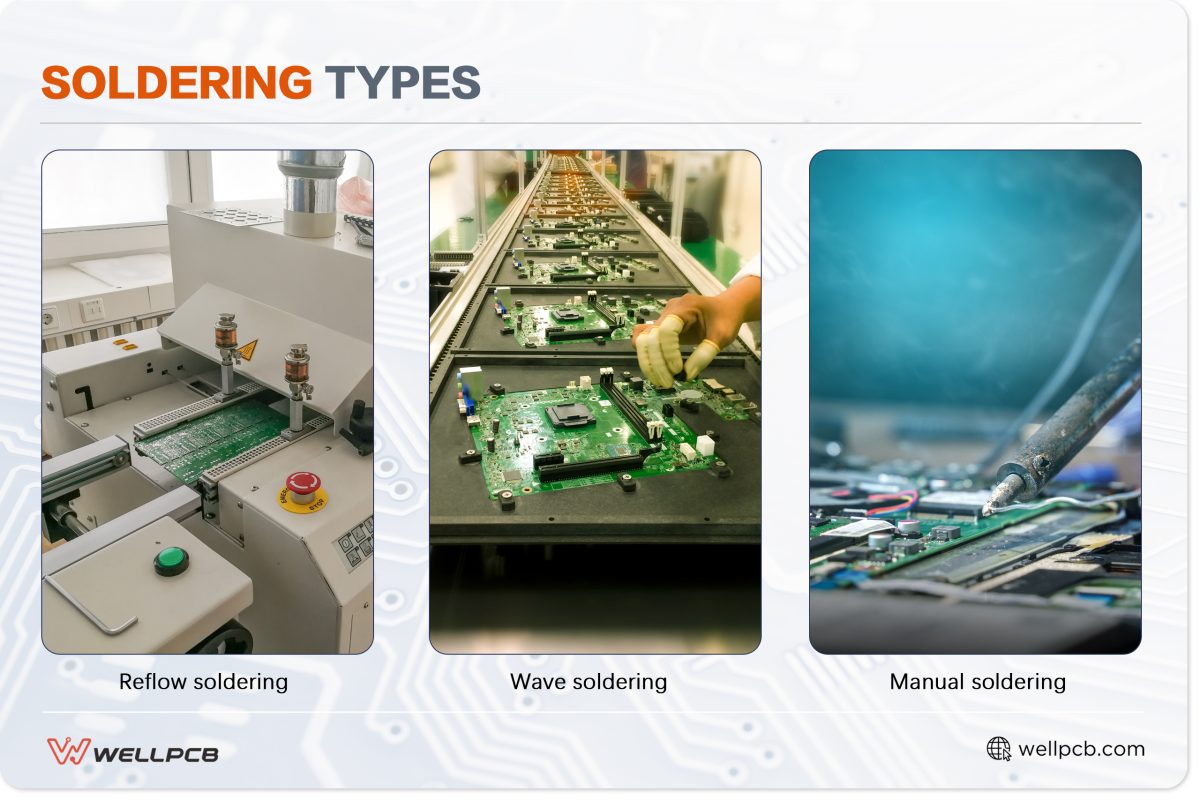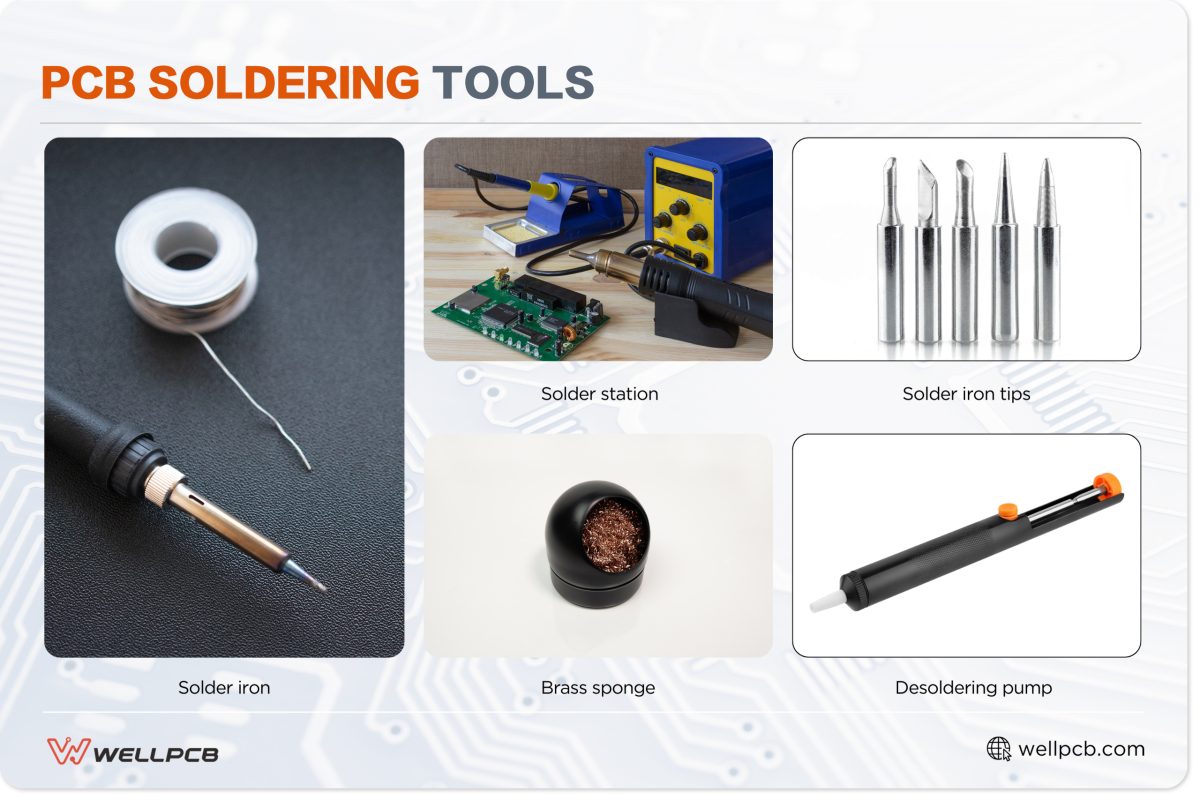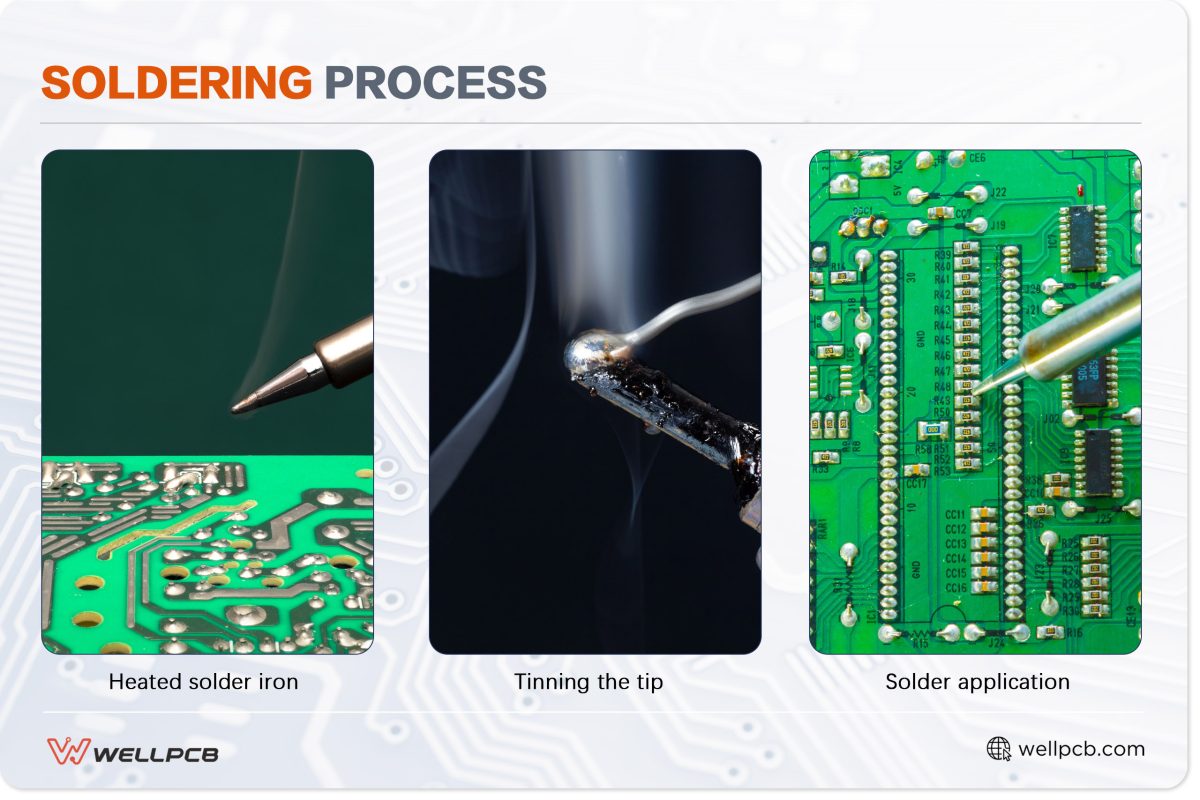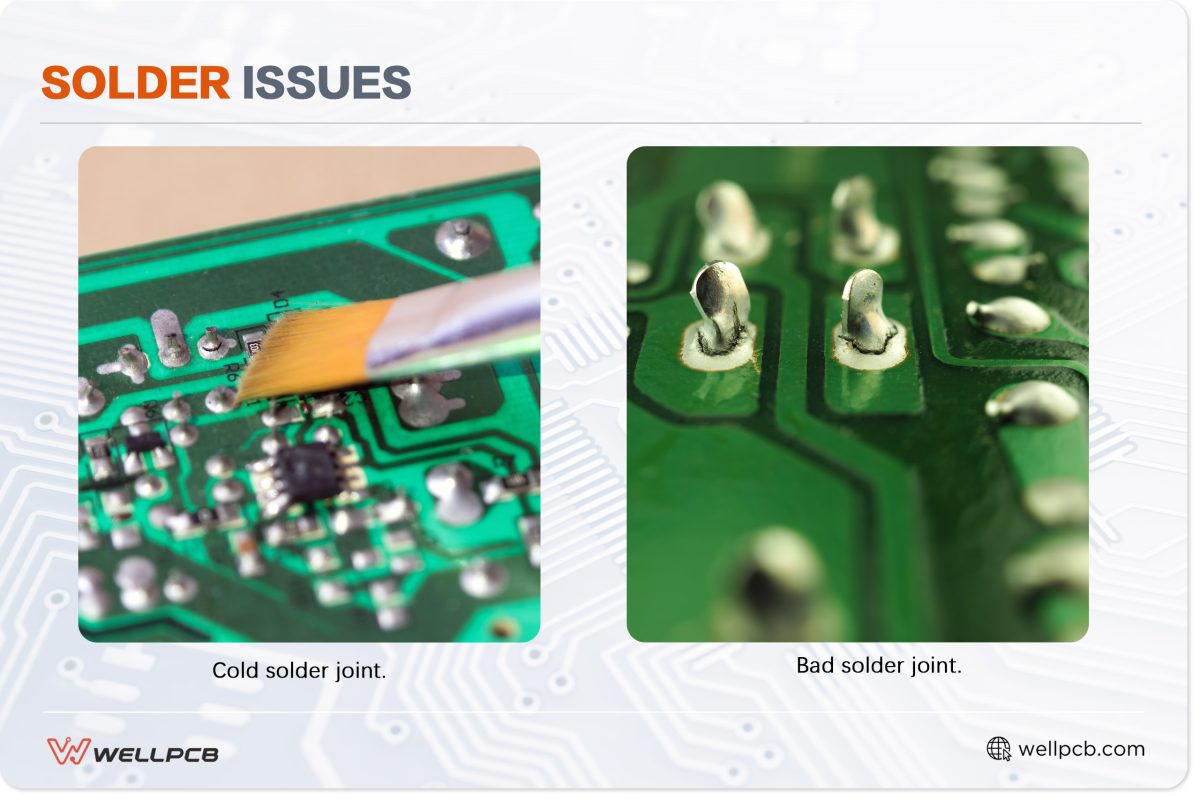Contents
- 1 What Are the Different Types of Soldering in PCB Assembly?
- 2 How to Choose the Right Solder for Your PCB Assembly?
- 3 What Are the Essential Tools for PCB Soldering?
- 4 What Are PCB Soldering Steps?
- 5 What Are Common Soldering Issues and Solutions?
- 6 What Are Safety Precautions in Soldering?
- 7 Conclusion
What Are the Different Types of Soldering in PCB Assembly?

[Image: Soldering types]
Figuring out which solder type to use is challenging. The right one is crucial for assembly. Here are the three most common types:
Reflow Soldering
The solder paste goes on the PCB contact pads before placing surface-mount components.
Component leads settle in the same position as the solder paste. Afterward, the PCB is placed in a reflow oven, exposing it to heat and activating the flux. At this point, the temperature increases, melting the solder to form solder joints.
Cooling takes place last, hardening the solder joints.
Reflow soldering is practical for the following scenarios:
- Large-volume PCB and device production
- High-density component soldering
- Compact and dense PCB assembly
- Integrating SMDs on PCBs
Reflow soldering has many advantages. For example, it uses less solder material and heat, improving its energy efficiency.
Defects, cold solder joints, and solder joints are less likely to form. Plus, the solder joint quality improves with reflow soldering.
Wave Soldering
Wave soldering involves five steps. The first step consists of applying flux on the PCB surface for cleanliness. Heating the board activates the flux.
Then, the PCB moves through a molten solder wave that goes on the metal surfaces to solder PCB components.
Those solder joints harden via cooling, keeping the components in place. Finally, the board undergoes cleaning to remove leftover solder.
Wave soldering is a large-scale process that involves soldering electronic components on a PCB, creating an electronic assembly.
Manual Soldering
This type is a good choice for prototyping and reworking or repairing circuits. Manufacturers and hobbyists prefer manual soldering for component integration.
They use manual soldering to attach components to a PCB with parts already mounted.
Some basic skills in manual soldering include tinning, applying heat, and technique.
Tinning promotes effective heat transfer. The right heat application results in a good solder flow and joint. Using the right technique forms durable solder joints.
How to Choose the Right Solder for Your PCB Assembly?
The solder material is important as it can create strong solder joints. Each one has different characteristics suitable for varying applications.
Lead vs. Lead-Free Solder
- Lead alloy solder:
This type is a mixture of 60% tin and 40% lead. Generally, lead alloy is easier to solder as it melts solder at 183°C. It produces rigid solder joints due to its excellent flow properties.
However, lead solder isn’t ideal for extreme heat applications. It may cause delamination, connection failure, component detachment, short circuits, and other problems.
- Lead-free solder:
These solder types have tin, copper, and other metals. Lead-free solder is ideal for applications exposed to high temperatures. Some formulas provide better durability as they have a stronger joint.
They have a higher melting point (217°C to 220°C) than conventional ones. Another downside is producing decent solder joints is more challenging due to wetting and solder flow issues.
- Silver Alloy Solder
If the project requires high temperatures, use silver alloy solder. It nearly matches lead solder’s melting point, making it a practical substitute.
Silver solder also binds different metals while filling tiny spaces via surface tension effects.
Solder Size
The solder size depends on the project. For example, small components or dense PCBs may require a solder wire of 0.5mm to 0.8mm in diameter.
Most electronics work, such as soldering through-hole components, requires a solder wire of 0.8mm – 1.2mm in diameter. A solder wire of 1.2mm to 1.6mm in diameter is ideal for larger components.
What Are the Essential Tools for PCB Soldering?

[Image: PCB soldering tools]
Assemblers will need these tools for soldering. They enhance the process, especially for solder application and cleaning.
Soldering Iron
- A few soldering iron types are available for electronics projects.
- Standard types are best for hobbyists creating a project or performing repairs.
- Cordless solder irons run on batteries and can be used remotely.
- Lastly, temperature-controlled solder irons enable temperature changes — ideal for soldering sensitive components.
When choosing a soldering iron, consider the features it may offer. For example, the temperature control makes it easy to precisely solder components without causing damage. Meanwhile, quick heating gets the solder job done faster and more efficiently.
Additional Tools
- Soldering Stations: These serve as multipurpose tools that solder electronic components onto a PCB. It features a soldering iron, power supply, and more for better functionality. PCB manufacturers and hobbyists heavily use soldering stations.
- Soldering iron tip: These consist of copper for transferring heat to the board. That copper has an iron coating, helping it last longer and keeping it corrosion-free.
Soldering tip interchangeability is dependent on the brand and model. Unless manufactured by a single company, tips are not compatible. Conical tip (pointed and for small components) and chisel tip (flat end for large components) are the two most basic types.
- Brass or traditional sponge: These essential tools are for cleaning the soldering iron tip. They also prevent oxidation at the end.
- Solder Sucker: It serves as a device that removes excess solder on the board. Without a solder sucker to suck the excess solder, the project may fail.
Maintenance Tips
If all the soldering tools are in excellent condition, they last longer and improve quality. Taking care of wear and tear prevents damage, requiring repairs.
Proper maintenance ensures the tools are safe and won’t harm the operator.
What Are PCB Soldering Steps?

[Image: Soldering Process]
Follow these steps to ensure a successful solder for your circuit:
Preparation
Clean the working station before starting the project. Compressed air or isopropyl alcohol is the best way to remove dust or dirt.
Use a static mat to prevent static electricity from interfering with the PCB.
The particles may cause short circuits, shorten component life, and form poor connections.
After cleanup, gather the soldering iron, stand, solder, flux, safety glasses, and a multimeter.
Soldering Process
- Warming the iron
Preheat the soldering iron. Otherwise, the solder won’t heat and melt properly. Warm up the iron by setting the temperature and let it rest for five to ten minutes.
The indicator light powers off or changes color when the solder heats to the preferred temperature.
- Tinning the tip
Cover the tip with a thin layer of solder. Apply a small amount to prevent potential problems. Once you tin the tip, wipe excess solder using a damp cloth. The tip should appear shiny and clean. Excess solder damages components, creates messy solder joints and reduces heat transfer.
- Solder application
Solder one or two components simultaneously on simple circuits. If you’re dealing with a complex PCB, solder the small components before the large types.
Place small components in their respective spots on the board. Through-hole components require bent leads at a slight angle to hold them in place.
For proper joint heating, hold the iron so that the tip touches the component lead and PCB pad.
This enables efficient heat transfer for proper solder flow, preventing stickiness on the component leads. Ensure joint overheating doesn’t occur. If solder bubbling forms, remove the heat and let the joint cool before reheating.
Use the soldering iron tip to touch the component lead and pad, applying the solder on the joint.
If you have heated this space as required, the solder should flow freely while the flux bubbles.
Add sufficient solder to form a slight, hollow curve around the joint. Don’t move the board once the solder flows into the joint, as it may produce a dull, grainy solder joint finish.
Post-Soldering
Inspect the solder joints after they cool. If they appear smooth, use wire cutters to trim the excess leads.
Then, use isopropyl alcohol and a microfiber cloth to remove extra flux residue from the board, leaving a clean finish.
What Are Common Soldering Issues and Solutions?

[Image: Solder issues]
If we don’t apply the solder properly or use the wrong temperature, a lot can go wrong. That can affect performance and circuit lifespan. Here are a few issues and solutions to consider:
Cold Solder Joints
This occurs if the joint heating duration is significantly short. You can see cold solder joints by visually inspecting the area.
It’ll have a dull, grainy finish compared to proper solder joints. Component leads may have incomplete solder coverage in this scenario.
Repairing cold solder joints isn’t complicated. Just reheat the joint using a hot iron until the solder melts.
You can add new flux for better solder bonding. Another option is removing the old solder and replacing it with joint resoldering.
Excessive Solder and Solder Balling
Too much solder on a board creates solder balls on the PCB surface or the solder joint. This may cause long-term PCB performance degradation.
Prevent solder balling by storing the PCB in a dry area and baking it before soldering (removes moisture). Applying solder paste evenly at the right amount will also help.
Use a vacuum desoldering pump or solder wick to remove the solder balls.
Applying flux to the area may remove unwanted solder. Clean the PCB after correcting the issue to eliminate loose solder.
Setting the proper solder and preheating temperature, changing flux, and cleaning solder dross prevents excess solder.
Insufficient Wetting
Improper solder joint wetting causes poor connections and performance issues in the PCB.
Contaminations, insufficient flux, and component surface joint oxidation can lead to insufficient wetting.
You can solve this by setting the proper temperature on the soldering iron.
Applying heat evenly on the pad and component leads, cleaning the workstation, and using high-quality flux help solve the issue.
What Are Safety Precautions in Soldering?
Safety is paramount during PCB soldering. You don’t want to work with people injured or cause bodily harm. The following are essential safety soldering guidelines to follow:
Temperature Handling
High temperatures during soldering may cause skin burns and component damage. Don’t place the iron on the joint for longer than three seconds.
It’s important to wear heat-resistant gloves and safety glasses while soldering to prevent burns.
Fume Management
Soldering leads to fumes emissions, which harm your health if inhaled. Wear a respirator designed to prevent the inhalation of those fumes — a dust mask may not provide adequate protection.
Safety glasses and gloves keep your eyes and hands protected, too.
Excellent air ventilation also helps. A fan or an open window keeps the fuses away from your face.
Tool Safety
Inspect the tools for potential damage. Doing so keeps the soldering process running smoothly.
When finished, store the equipment in a safe place, like a locked drawer, away from children and pets. You can put all the tools in a toolbox for organization and protection.
Conclusion
Soldering is necessary for PCB component integration. As noted, you’ll need to use the right tools, techniques, and materials for the project.
Tools in excellent condition ensure longevity and safety. Cold solder joints, solder balling, and insufficient wetting may occur.
You can avoid these by implementing the best practices.
Be safe when you solder components to the PCB. Doing so prevents damage and health hazards, like burns or fume inhalation.
Wear protective gear, including a respirator, gloves, and safety glasses, while soldering. At the end of the day, you’ll want to finish the project without harming yourself or the board.





